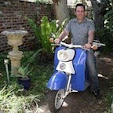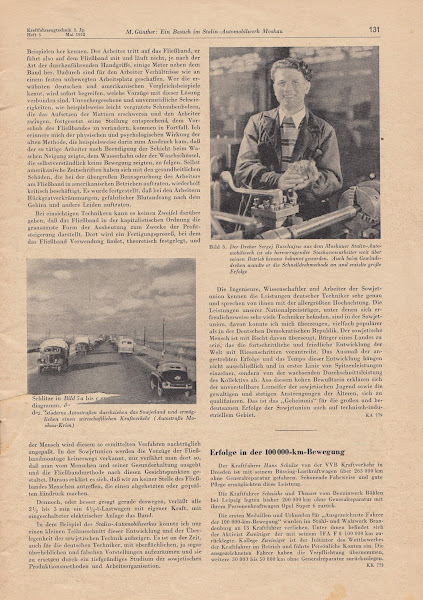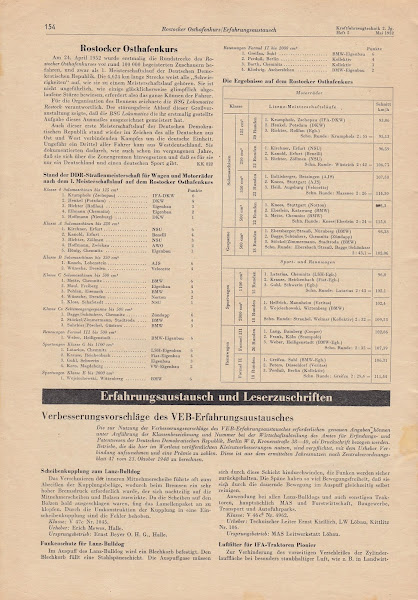
East Germany gets short shrift in the English speaking world. After Germany's defeat in the Second World War, the country was divided into four occupation zones. The states of Mecklenberg Pommerania, Brandenburg, Saxony and Upper Saxony and Thuringia came under the administration of a Soviet occupation government. Unlike their former partners in the west, the Soviets diligently removed ardent Nazis and Nazi sympathizers from positions of authority, and, as the Nazi system required the owners of all large and strategic industries and insititutions to be members of the Nazi Party, this helped them dispossess the capitalist and industrialist class. Socialists, union leaders and Nazi opponents were elevated into positions of authority and established a socialist regime under the Socialist Unity Party.

Germany was a nation of many parts and its wealth and industry was not evenly distributed. Eastern Germany was primarily rural and agricultural, with only a smattering of heavy and technical industries. In terms of its auto industry, East Germany had the BMW plant at Eisenach, the Auto Union group in Saxony (Chemnitz, Zwickau and Zchopau), the Framo light truck plant in Hainchen, the Phaneomen heavy truck factory at Zittau, the FAMO tractor plant at Dessau (the FAMO plant was originally in Posnan in what was now Poland, but as the front advanced toward Germany, it was dismantled and shipped to Dessau. The war ended before the factory could be re-established), and a smattering of bodyshops and parts manufacturers. In addition, there was the Junkers aircraft plant at Dessau and the Daimler-Benz aircraft and marine engine plant in Ludwigsfelde. Almost all specialist technical component manufacturers were situated in the west. The problems caused by this imbalance would not be felt for some time as despite different regimes operating in each occupation zone, the country was still considered to be unified nation.

Inevitably, the different economic policies pursued by the occupying powers led to tensions between the zones. The French pursued their own policy in opposition to all the the other parties, strip mining the French zone in the name of reparations. The US absorbed the bankrupt British zone into 'Bizonia' and supported the restoration of Germany's industrialists, while the Soviets pursued the opposite approach in their zone via the nationalization of industries. These differing and indeed contradictory policies caused enormous economic problems for Germans and in 1947 there were protests and riots in the Western Zone. Both the Soviets and the British pushed for an all-German currency reform and a unified economic policy. The US however opposed this and in 1948 forced through a unilateral currency reform for the western 'Trizone' (including the French zone). This move was designed to cut all trade with the Soviet zone by undermining East German food exports and replacing them with subsidized American imports. The Soviets could not permit the newly subsidized Deutschemark to circulate freely in their zone so they implemented currency controls, which the US circumvented by smuggling the new Mark into Berlin through their mission. This was the real cause of the Berlin Blockade. Had the Soviets really wanted to seize west Berlin, they could have at any time and the Western Allies could not have prevented them, but this was never the Soviet's intention. While the Western Allies spent hundreds of millions of dollars flying supplies into West Berlin, the Soviets implemented their own currency reform in East Germany which was substantially more favourable to workers. Even West Germans travelled to the East to convert their old Reichmarks. The western zones established themselves as the Federal Republic of Germany on 23 May 1949. The Democratic German Republic (GDR or DDR) was founded on 7 October 1949. Both states claimed to be the legitimate successor of Germany.

Relations between the states progressively degenerated with trade and travel between east and west becoming increasingly difficult. For East German industry, especially the automotive industry, the loss of access to imports of specialist technical components, such as bearings, electrical components, carburetors and brakes, caused massive problems. The State consolidated the automobile industry into a publicly owned conglomorate called VEB. New domestic parts suppliers were established from scratch.

In 1952 the Soviets proposed to the other occupying powers that a final peace treaty be settled between Germany, the victorious powers and Germany's neighbors, putting an end to the occupation regimes and allowing the country to be reunified. The proposed Soviet peace treaty was extremely generous to Germany as a whole, but the Western Allies refused to accept the requirement to withdraw their military forces from the country. The US pushed its West German client to reject the peace treaty, accusing the Soviets of bad faith and deception.
The US and Britain would constantly accuse the Soviets of bad faith in all their negotiations, but the same offer had been made to Austria, which was also divided into four occupation zones. The Austrians accepted the peace treaty and all occupation forces were withdrawn from the country the following year. In exchange Austria declared neutrality. The US' refusal to engage with the Soviet offer led directly to the escalation of the Cold War with West Germany becoming NATOs forward base against the Soviets.
For the Socialist Unity Party (SED) in East Germany, the failure of the German reunification initiative was a godsend. In any national election, the SED would have lost their grip on power, although they may have retained some regional influence in the east. Now they were the only game in town and SED general secretary Walter Ulbricht intended to exploit this. A hardline Stalinist, Ulbrecht set about the aggressive nationalisation of industries and collectivisation of agriculture. It was undeniable that East Germany needed to increase its industrial capacity and achieve self-sufficiency in response to the western blockade, but the SEDs methods caused massive disruption and unrest. There were also behind the scenes tensions between the GDR and the Soviets, who did not support Ulbrecht's heavy handed approach. Within East Germany food prices skyrocketed and shelves emptied of consumer goods, resulting in protests around the country. Ulbrecht and the SED pressed ahead regardless, forcing additional unpaid work hours on workers to meet quotas. Matters came to a head on 16th March 1953 when protests against working conditions and inflation got out of control On the 17th March the government put tanks on the streets. Calm was returned at the cost of several dozen lives, but it was a near run thing with tremors reaching as far as Moscow.
Hardline communist ideology was forced - begrudingly - to give way to a new, softer approach. The new industrial plan for 1954 focused on consumer goods and an improvement in living and working conditions. The motoring sector, which had struggled along since the late 1940s was completely reorganized to improve efficiency. While tractors and trucks were essential for reconstruction, personal transport in the form of motor scooters and cheap cars were now prioritized. Motor sport, formerly frowned upon, was encouraged.

By the late 1950s things were looking up all over Europe, including in East Germany. Most westerners would be surprised to realize that East Germany effected a quicker recovery than its western counterpart, although it was starting from a much lower population base. Nevertheless, there were serious problems.

During the Soviet occupation period, the Soviets had formed a state-owned vehicle design bureau to plan for the recovery of the automobile industry. The bureau brought together the heads of the various companies in East Germany and evaluated vehicle designs. The Soviets saw two development opportunities in the BMW 340:

and the Wanderer W24.

Both of these were middle-class four-cylinder cars from well-known brands that could be expected to sell well and generate export income. The BMW 340, had been developed in secret during the war and would be showcased at international motor shows across Europe from 1948. The Wanderer factory however had been destroyed during the war so reconstitution of the popular W24 was more challenging. While feasibility studies were underway, the design bureau put forward another recommendation - the revival of the DKW F9. Designed as a more upmarket competitor to the Volkswagen, the F9 with its three cylinder two-stroke motor appeared at first glance a simpler proposition, two-stroke engines being far easier to manufacture and maintain. As Auto Union had lost all its prewar F9s, the reconstituting the project virtually from scratch was no mean feat, but by 1948 the first cobbled together cars were presented to the public. It was a huge step forward. The F9 was joined by its predecessor, the wooden-bodied F8 rolling out of the old production lines, virtually unchanged since 1940. https://dkwautounionproject.blogspot.com/2020/07/the-development-of-ifa-f9.html

The decision to revive the heritage of the DKW brand of Auto Union was the correct one for the time. In the early 1950s when the west moved to economically blockade the east, the big BMW 340 car would find itself frozen out of its export market. It was too expensive to find a domestic market so the former BMW werkes at Eisenach took over mass production of the F9. By 1955, DKWs two-stroke motors had come to dominate the East German motoring scene, with the three-cylinder 900cc motor being used in the F9 and the Framo 901 light truck, the twin-cylinder 700cc motor being used in the F8 and AWZ P70, not to mention DKW's motorcycle engines in a range of vehicles. The two-stroke would become the motor of choice for East Germany.

Despite an improving economic situation, the GDR suffered from ever increasing westward migration and in 1961 took extreme measures to stem the flow, building a wall along its entire border with West Germany and restricting the movement of its citizens. This was the beginning of East Germany's long, slow moral and economic decline. The SED regime clung to power with increasingly repressive measures, contributing to national demoralization. Attempts in the late 1980s to improve relations with West Germany saw some economic improvement, but it was not enough and the stage was set for the GDR's decline.

In August 1989 Austria and Hungary opened their respective borders to each other, which opened a route for East Germans and others wanting to go west. Soon there were long convoys of ossies leaving the country. The SED attempted to close their border with Hungary, but the momentum was unstoppable. The SED appealed to the Soviets to clamp down on the Hungarians, but Soviet Premier Mikail Gorbachev refused. Protest began along the wall separating east and west Berlin from both sides and when East German border guards stood aside, the protestors began demolishing the wall. The East German government collapsed. On 3 October 1990, the German Democratic Republic was disolved and joined the Federal Republic of Germany.

In the west, the many negative aspects of the GDR - which are terrible - are accentuated. The GDR is portrayed as a Soviet puppet, without a will or policy of its own, a prisoner to Moscow's dictats. This was never true. The GDR was a particularly German regime, often at odds or distrustful of its Soviet 'guardian.' It adopted a very German socialism that was easily integrated with the prior regimes national socialism. In the early years, the themes of peace and harmony were strongly promoted in all state propaganda, something that comes through even in the motoring and sporting magazines.

Unfortunately, despite subsidies and industrial investment from the Soviet Union, East Germany never had the resources and population to realise the SED's grandiose visions. The struggle to overcome the challenges caused by the war, of starting to rebuild entire industries from scratch is apparent through the pages of the various motoring magazine archives shared here. The struggle builds to a sense of triumph and satisfaction in the early 1970s when the ossies may have considered themselves well off and comfortable in the scheme of things, before the rot and demoralization sets in, until the inevitable collapse.
Magazines are grouped by publication and in date order and include:
1. Illustrierter Motor Sport:
https://gdrfahrzeuge.blogspot.com/2023/06/illustrierter-motor-sport-index.html
2. Das Deutsche Strasse Vehrker: https://gdrfahrzeuge.blogspot.com/2023/06/der-deutsche-strassen-verkehr-index.html
3. Kraftfahrzeug Technik: https://gdrfahrzeuge.blogspot.com/2023/06/kraftfahrzeug-technik-index.html
4. Das Magazine (culture and entertainment):










































